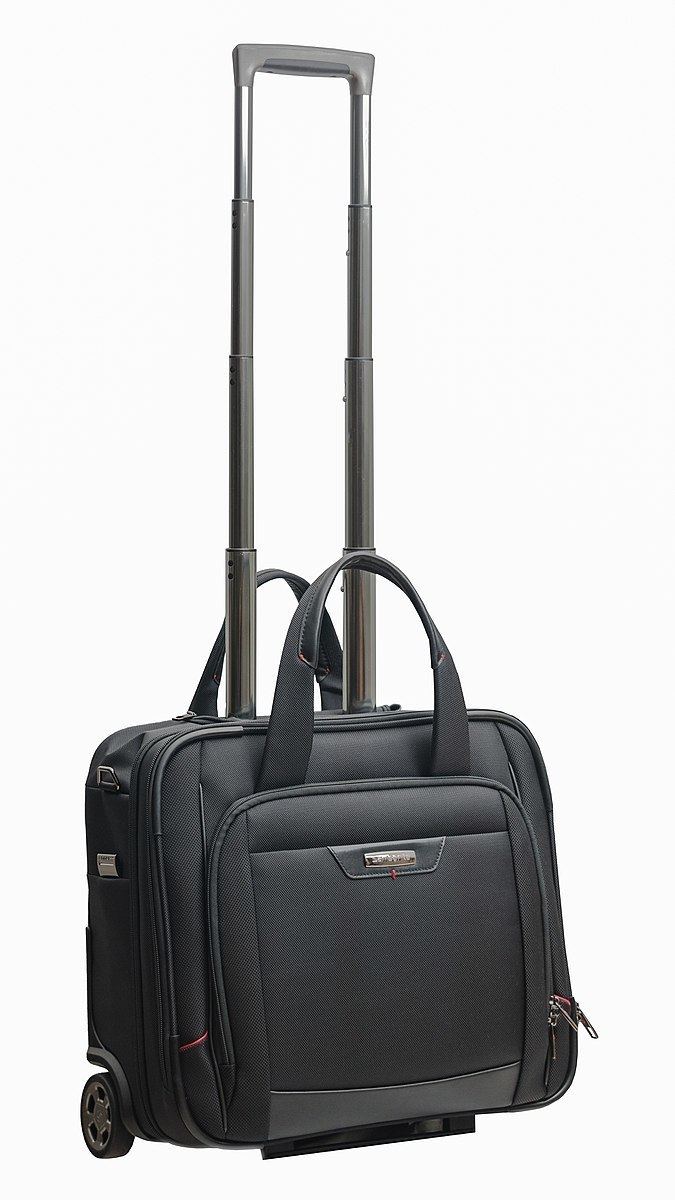 | ||
A suitcase is a general term for a distinguishable form of luggage. It is often a somewhat flat, rectangular-shaped bag with rounded/square corners, either metal, hard plastic or made of cloth, vinyl or leather that more or less retains its shape. It has a carrying handle on one side and is used mainly for transporting clothes and other possessions during trips. It opens on hinges like a door. Suitcases lock with keys or a combination.
Contents
History
Originally, suitcases were made of wool or linen. Leather also became a popular material for suitcases. It was used to cover wood suitcases or just on its own for collapsible suitcases. It is difficult to document all the materials suitcases have been made out of. Like all produced consumer goods the materials chosen to construct suitcases are truly a product of their time. Wool, wood, leather, metal, plastic, fiber composite even recycled materials are all common suitcase materials. During covered wagon times trunks were a popular form of transporting goods. The ride was rough, so the luggage had to be strong. The theme of suitcases becoming less cumbersome over time could be directly related to the advancement of better transportation.
20th century
As transportation changed, soft sided suitcases manufactured from polyester prevailed. The original 'Halliburton' aluminum travel cases were handmade for Erle P. Halliburton's personal use in 1938. In 1950 Rimowa introduced the mass market aluminum suitcase based on the Junkers Ju 52 airplane shortly followed by Zero Halliburton. Nylon suitcases prevailed afterwards. Bernard Sadow, first patented wheeled luggage in 1974. In the mid 1980s, Andiamo was the first company to incorporate ballistic nylon into luggage.
21st century
The first suitcases made from polycarbonate were in 2000 by the German luggage maker Rimowa. Most luggage manufacturers has make some suitcases from the material. There are many grades of polycarbonate.
Both acrylonitrile butadiene styrene (ABS) which was cheaper than polycarbonate, and polypropylene which was lighter than polycarbonate were introduced shortly after polycarbonate. Spinner style wheeled suitcases were introduced in 2004.
Construction
The most sturdy suitcases are generally constructed from polymers such as nylon and have a covering that resists gouging and liquid from entering into the interior. The seams can be glued together or stitched with strong nylon thread. Generally the stitched-together suitcases hold up over time as compared to the glued construction and have a lock or latch.
Many modern suitcases have built-in small wheels enabling them to be pulled along on hard flat surfaces by a fixed or extendable handle or by a retractable or stowable leash. Suitcases are a type of luggage. A smaller, firmer suitcase, used mainly for transporting papers and office supplies is known as a briefcase. Some cases are made from proprietary materials such as Cordura or Tegris.
Variations
Some suitcases that include a telescopic handle and wheels are known as trolley cases (UK) or a roll along (US). Trolley cases/roll alongs typically have two fixed wheels on one end with the handle located on the opposite for vertical movement. Smart suitcases are getting more and more popular. Typically they can be controlled via your smartphone application and have features like: GPS, smart lock, auto follow and other.
